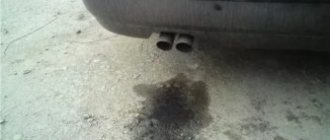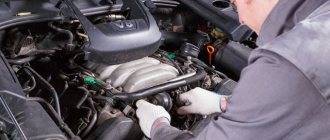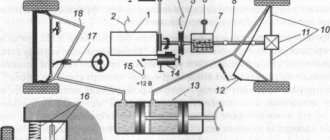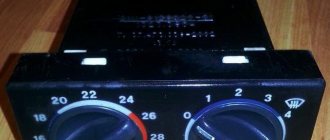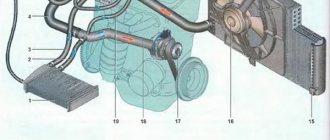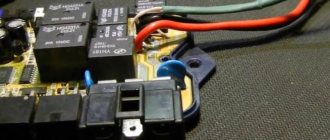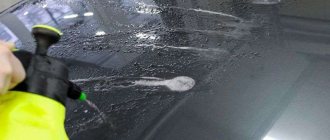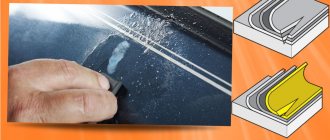An experienced motorist can easily distinguish between normal vibrations when accelerating and a cause for serious concern. In the first case, an increase in engine speed and vehicle speed will inevitably affect the level of comfort; in the second case, the source of increased shaking will be a specific malfunction.
Please note that such symptoms require diagnosis and immediate elimination. The point is not only an unpleasant beating on the steering wheel and an increase in noise in the cabin, but also a decrease in the level of directional stability and the likelihood of progression of the malfunction. The latter factor can lead to expensive repairs.
Let's start listing with the most banal and common reasons.
Balancing required
Runout on the steering wheel and car body with increasing speed is inevitable if the wheels are not balanced. The uneven distribution of mass relative to the center of the wheel rim leads to such consequences. The action of multidirectional centrifugal forces leads to the appearance of multi-frequency oscillations, which are felt as a beating in the car interior.
The problem may manifest itself in the following cases:
- Installing new tires. Replacing tires on rims or putting new rims on old tires must be accompanied by balancing. Even for the manufacturer, achieving ideal weight distribution and geometric parameters seems to be an extremely difficult task.
- Loss of old balancing weights. This is especially true for light alloy wheels, where the weights are glued to the inside of the wheel. Let us remember that in the case of stamped rims, the weights are placed in the outer shoulder of the rim.
- Deformation of the rubber or disk due to falling into a deep pothole, a strong impact with the curb and other similar obstacles.
- Natural imbalance. During operation, any wheel will lose its established balance. It is recommended to carry out scheduled balancing every 15-20 thousand km.
Another breeding ground for imbalance is often the constant velocity joint. It serves as a device for the movable articulation of the drive shaft and gearbox, which allows the transmission of torque in different planes (internal CV joint). At the other end of the drive shaft for articulation with the hub (outer CV joint).
Most often, the cause of vibrations lies precisely in the internal hinge. In the case of a tripod-type design, wear out of the rollers is observed. In especially severe cases, the bearing may even “fall apart”. It is also possible to produce a tripod glass.
A similar malfunction can be caused by a torn boot, which can no longer protect against dirt and dust flying from under the wheels. Therefore, periodically check the integrity of the CV joint boots.
Drive shaft
It will be worth mentioning that a car with a drive of irregular geometric shape is guaranteed to experience vibration when accelerating. A bent drive shaft will not only rotate around its axis, but also provoke parasitic centrifugal forces. As a result, the car will receive additional vibrations as it accelerates.
Cardan
The problem is typical for cars with rear-wheel drive and all-wheel drive. Wear of the cardan joint leads to vibration during acceleration. If you encounter a similar problem, pay attention to the following elements:
- crosses;
- suspension bearing;
- directly to the driveshaft. An unbalanced cardan will lead not only to beating, but also to subsequent destruction of the joints.
There were cases when the cause of runout at speed was play in the gearbox shank. This also needs to be paid attention to.
Disorders in the nutrition system
Ultimately, they come down to improper formation of the composition of the combustible mixture. Typically, vibration at idle is a consequence of its depletion. It is possible to understand exactly which node or element is the source of the problem only with the help of special equipment. There are many reasons, below are just a few of them:
- fuel pump failure;
- contamination of the filter and (or) fuel line;
- clogged jets in the carburetor or nozzles in the ramp;
- incorrect carburetor settings, faulty sensors in the injection engine, etc.
Rubber
There are often cases when vibration when accelerating appears due to the installation of low-quality tires. Most often these are tires from budget and extra-budget manufacturers. The peculiarity of such rubber is that when checking on a balancing stand, a discrepancy that causes discomfort when driving a car may not be noticed. In the second case, balancing only temporarily delays the reappearance of vibrations. Only replacing the tires will solve the problem.
The next reason for the appearance of unwanted vibrations is typical for owners whose car is shod with low-profile tires. The side cord of such tires does not have the rigidity and elasticity that is inherent in civilian versions of tires. Therefore, prolonged downtime, especially in the warm season, can cause temporary deformation of the tire at the point of contact with the road surface. Therefore, vibration during acceleration may be observed for a short time after the start of movement. The first kilometers should be covered with extreme caution.
Broken suspension parts
If one of the shock absorbers is broken, it can cause shaking. It can also create different types of noise that will indicate to you that there is a problem with your suspension. Vibration can also start if there are problems with the suspension arms or any mounting.
Another possibility is that the suspension mounting points are broken. This can happen to older cars that have a lot of rust on the body. The installation site may rust, so the bolts will not hold up. This will result in you spending a lot of money on body repairs. Vibrations and sounds can be the result of problems with both the front and rear suspension.
We explore the engine compartment and engine sounds
If you determine that the vibration is coming from under the hood, most likely the cause will be improper operation of the engine or the mounting points of vibration-loaded elements.
Problems related to internal combustion engines:
- Engine tripping. Many car owners have encountered a situation where, when accelerating or driving under tension, the engine begins to shake, and the thrust is much weaker than before. In this case, comprehensive engine diagnostics is necessary. The problem may be hidden in the ignition system: worn-out spark plugs, GDP, module and other elements, the malfunction of which leads to misfire in one or several cylinders at once. Possible burnout of valves, insufficient fuel pressure, etc. There are so many reasons that the topic deserves separate detailed consideration.
- Engine support cushions. Vibration during acceleration will appear because an increase in engine speed increases the centrifugal forces acting on the car body. When you sharply press the accelerator pedal to the floor, noticeable shocks may be observed. Made of hard rubber, even new cushions will cause vibrations.
Gearbox and clutch drive
It is also worth paying attention to the mounting locations of the gearbox. Perhaps the reason may be hidden inside the gearbox housing. In the case of a manual transmission, for a more accurate diagnosis, you should pay attention to the factors causing vibration or beating. If symptoms only appear at a certain speed limit, try driving it alternately in different gears. For example, if vibration is noticeable at 70 km, first engage 2nd gear, then 3rd (of course, if the gearbox ratios allow). This way, you can more accurately identify the transmission components that cause vibration.
If there is deformation of the input shaft in the gearbox, vibrations will be noticeable when accelerating in any gear.
An unbalanced flywheel can also cause the symptoms discussed. At the same time, it is worth paying attention to the clutch and release bearing.
If the car has an automatic transmission, check the oil level and condition. An indicator that is too low can cause shocks and vibrations.
Exhaust system
Improper mounting of the engine exhaust system can lead to noticeable vibrations in certain engine operating ranges.
Transmission
Again, the transmission mount and support pads should be checked first. Then check the fasteners. If the car shakes during acceleration, or the car accelerates jerkily, check the transmission itself. In robotic transmissions such as Ford Powershift or Volkswagen DSG, the clutch system may be broken. In a traditional automatic transmission, shaking can be a sign that the transmission is about to die. But sometimes an oil change can extend the life of your transmission and help you deal with the problem of shaking and jerking.
Painfully banal
If the body vibrates when accelerating, you should not be upset and immediately count out a large amount for repairs. Below are some common and not so common cases that can cause discomfort when driving:
- Dirt or ice block stuck to the inner rim of the wheel rim. Diagnosing the adhesion of dirt is not difficult, since noticeable beating will occur only after off-road driving. In winter, every driver should be prepared for such troubles;
- Incorrect installation of brake and wheel discs. If the mating plane has not been cleared of contaminants or is deformed, this will cause an increase in vibration load during movement;
- discrepancy between the landing dimensions of the wheel rims. Each disk has its own installation parameters, violation of which can lead to imbalance. This mainly concerns disc bolt patterns;
- loose disk fastenings. This is the first thing to check when you notice runout in the steering wheel. The consequences of neglecting this advice can be very dire.
Wheel bolts
If your car starts to shake at low speeds and the vibration becomes unbearable when driving at 60 km/h, it means there is a problem with the wheel bolts or nuts. Stop driving immediately because one of the wheels may simply fall off if you continue driving. Park the vehicle carefully and check the nuts or bolts.
Driving with loose wheel bolts is very dangerous for your health and for the car. Suspension parts can break quickly and the wheel mounting system can fail, so you'll have to spend quite a bit of time and money on repairs. After visiting the service station, it is recommended to check whether the service workers have tightened the bolts well enough.
Tire imbalance
The reason for this phenomenon may also be defects in the rubber itself as a result of hitting an obstacle or falling into a hole (often at high speed), which causes the carcass elements on the tire to deteriorate and it takes on an irregular shape. This defect is called a “hernia.” It is almost impossible to correct it, but you can try to correct it by balancing the wheel. But even in this case, the steering wheel will vibrate at speeds of 90-100. What to do in this situation? Such a tire will still no longer work as it should, and it will soon have to be changed.
Fuel
Sometimes problems can be caused by the quality of the fuel. For example, if you fill up with diesel instead of gasoline at a gas station, the engine will begin to shake and vibrate, and then may simply stall. If you use low-quality fuel, the fuel filter will immediately become dirty, and it will be quite difficult for the fuel pump to provide the necessary pressure in the system. This can cause low fuel pressure in the fuel injectors, which can cause shaking and vibration.
Wheel bearing wear
This element ensures smooth rotation of the wheel on the axle. Its long-term operation is ensured by the correct tightening torque, at which it should rotate freely, but without play. An undertightened bearing, like an overtightened one, quickly wears out and begins to jam. This is quite easy to check. With the wheel removed, you need to release the pads and turn the brake disc by hand. If, when the latter rotates, the resistance to rotation increases from time to time and an extraneous sound appears, it means that the bearing is jammed. It should also disappear when the nut holding the bearing is slightly loosened. It won't last long in this condition.
Repairing shock absorbers with your own hands: is it possible, how to do it right
Having noticed the first signs, go to the service, carry out diagnostics or look for the reasons on your own. This directly depends on the available skills, experience and resources for carrying out independent repairs. Some reasons are frankly banal and can be easily eliminated without outside help. Others require the mandatory participation of specialists and the use of professional equipment.
Have you ever experienced a shaking car? What caused it and how did you deal with this problem? Share your stories and personal experiences in the comments.
Subscribe, leave reviews, ask relevant questions and tell your friends about our project!
Wheels do not comply with factory recommendations
A car rim has its own parameters - width, tire mounting diameter, offset, as well as the diameter of the drill, i.e. the circle on which holes are drilled for mounting bolts or studs. For each wheel model, the number of these holes and their diameter are indicated. If the disk parameters are incorrectly selected, the mount will not screw in completely and will not press the wheel tightly to the hub. As a result, the disk has play. If the diameter of the holes drilled does not match, the wheel will also not sit in its place. Of course, it can be planted using physical force. However, the plane of the disk will not coincide with the parameters of the hub. This is not good for the car.
Damage from vibration
ATTENTION! A completely simple way to reduce fuel consumption has been found! Don't believe me? An auto mechanic with 15 years of experience also didn’t believe it until he tried it. And now he saves 35,000 rubles a year on gasoline! Read more"
At speed, vibration of the car body is not only discomfort for the driver and passengers, it is also harmful to the car as a whole. After some time, cracks appear in the car body due to vibration. In addition, bolts and nuts begin to unscrew spontaneously, which leads to dangerous consequences in the future. Thus, there is a risk of emergency situations. In addition, vibrations are harmful to human health, cause vasoconstriction, impair blood circulation, lead to the deposition of salts in joints, reducing mobility, with prolonged exposure.
Worn or warped brake discs
These elements are installed on the hub and are clamped by pads when the speed decreases. There is practically no gap between the disc and pads. Therefore, the surface of the assembly must be perfectly flat. The slightest distortion of the disc causes the steering wheel to vibrate at speeds of 90-100 km/h. Warping of brake elements most often occurs due to frequent and intense braking, as well as when driving through deep puddles. The heated disk bends due to sudden cooling. This element cannot be repaired - only replaced.
The wheel alignment is broken
Directly depending on the incorrectly set angle, vibration can only occur during acceleration or in a certain speed range. Incorrect wheel alignment can be detected very quickly - tires wear unevenly.
If only the outer or only the inner part is wiped, then this is the same situation. The problem can be corrected by adjusting the angles. Then the vibration in the body at a speed of 100-120 km/h will disappear.
But the camber/toe has been adjusted, but the problem has not gone away. The angle has been corrected, that's a fact. But the car owner decided not to change the tires, because they can still drive. But the tires “drive” the way they are used to. This means that you need to change the tires or drive at low speeds for a period of time, then the tread will wear out evenly and the problem will be solved.
Brake problems
If you notice vibrations when applying your brakes, it is highly likely that you are dealing with a worn or worn brake rotor. If this is the case, you will experience a shaking steering wheel when braking or a pulsating sound directly through the brake pedal. Make sure the rotor is checked and is in good working order or completely replaced.
Another cause is a worn or rusted brake caliper pin, but this usually only affects older cars. If this is the cause of the vibrations, you will feel your steering wheel begin to vibrate at a speed of 50 kilometers per hour. It will get worse as you speed up and you may notice a burning smell when you stop.
Keep in mind that from a safety perspective, a car's braking system is one of the most important systems in a vehicle. It is sensitive to wear, so be sure to keep it in good condition by checking your brake pads, rotors and all other brake system components regularly and promptly.
Spare parts, maintenance
Products from the Dustershop77 range that may be of interest to you:
| Name | Manufacturer | Price | Availability | Add to cart |
| DC495 | Discount card (Dusterclubs.ru, Dustershop77.ru) | 700 / 500 rub. Discount: 500 rub. | >10 | |
| DC218 | Air deflector “Warm feet” for Duster, Logan, Sandero, Largus | 900 / 350 rub. Discount: 250 rub. | >10 | |
| DC654 | Frill with fastening without 3M tape (Duster/Terrano) (ArtForm) | ArtForm (Yuago) | 3000 / 2000 rub. Discount: 1600 rub. | >10 |
| PT014-RDU112901 | Trunk sill trim PTGroup | Pt GROUP | 1200 / 1000 rub. Discount: 900 rub. | >10 |
| 005-008502 | Trunk sill protection | Russian Artel | 1400 / 1100 rub. Discount: 1000 rub. | >10 |
| R12711 | Wind deflectors (window deflectors) COBRA/Autoplex | COBRA/Autoplex | 2000 / 1600 rub. Discount: 1500 rub. | >10 |
| DG-006-GARD-RDSHCH | Front diffusers - aerodynamic flaps Renault Duster (set of 2 pieces) | Duster-Guard | 700 / 600 rub. Discount: 500 rub. | >10 |
| NRD-009102 | Frill under the windshield (RA) | Russian Artel | 2500 / 2100 rub. Discount: 1800 rub. | 5 |
| RA0052 | Door sill trims (front+rear) RA | Russian Artel | 2500 / 2000 rub. Discount: 1700 rub. | >10 |
| DC1024-V117 | Windshield and roof edge seal | Duster-Guard | 700 / 500 rub. Discount: 300 rub. | >10 |
